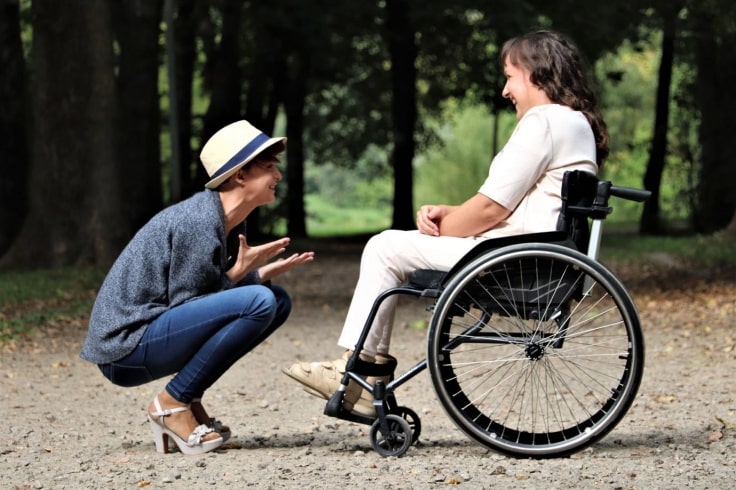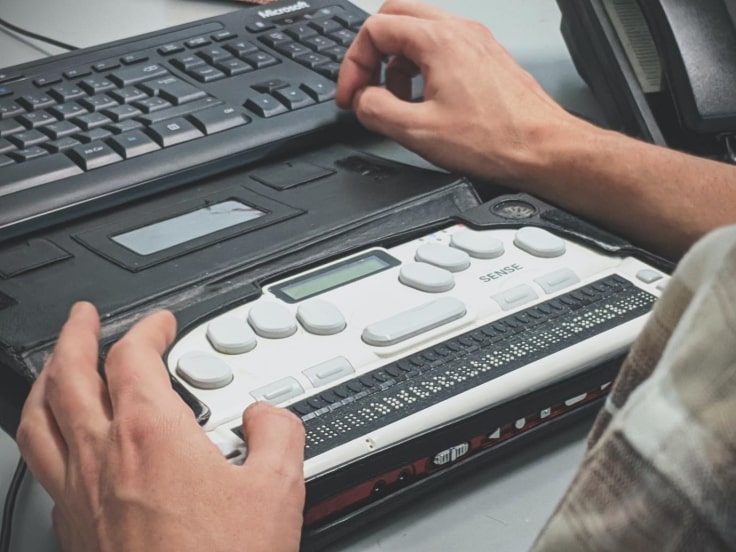How Technology Is Enhancing The Lives Of Impaired People

Technology is the single biggest support for disabled and impaired people, allowing them to perform daily functions they wouldn’t be able to without it. But how?
Disabilities and impairments come in all shapes and sizes, making it difficult to find a one-size-fits-all solution.
Some conditions alone, such as cerebral palsy, cause multiple disabilities, requiring advancements in many fields to help them live an easier life.
To tackle these struggles, new technologies are being created all the time. With smartphone and AI technology growing exponentially, disabled people now have more choices than ever on how to manage their condition.
In this post, we’re going to discuss why we need technology to help impaired people and give some examples of technology that exists currently that is helping people with specific disabilities.
We’ll then take a look at what the future of technology for impaired people looks like.
Why Do We Need Technology To Help Impaired People?
Around a billion people worldwide have some sort of disability, according to the World Health Organisation. In Europe and America specifically, this translates to one in five people.
These people are generally less able to work, making their rate of poverty twice that of their able-bodied peers.
Smart technology aims to help disabled people keep up with a more tech-focused world that threatens to further exclude them from the workforce.
This not only involves making technology to help disabled people work. It also involves making sure any new apps and programs are as accessible for the disabled as they are for everyone else.
There are also advances in AI technology that make it possible to assist people with disabilities in ways impossible until now.
In the next section, we’re going to discuss some of these technologies and the disabilities they are useful for.
What Technologies Are Available For Different Types Of Disabilities?
Now that we have an idea of why technology is necessary for people with disabilities, it’s time to look at a few specific disabilities and how new technology helps them:
1. Cerebral Palsy

Cerebral palsy (CP) causes a vast series of disabilities. So looking at how technology can help people with this condition really shows how varied this technology is.
People with CP can find it difficult to walk, communicate, and in some cases, hold a pencil.
Assistive Technology
Assistive technology for CP can help with:
- Academic performance;
- Inclusion in activities and recreation;
- Social life;
- Communication with others;
- Ability to express emotions;
- Self-confidence;
- Independence and self-sufficiency;
- Opportunities.
Movement
The traditional types of technology used for movement impairment are walkers, wheelchairs, and stairlifts.
However, new technology is being tested that delivers electrical impulses to stimulate specific muscles, making it easier to walk.
Communication
In terms of communication, electronic communication boards, and tablets with specific apps, are really helping. They allow people to select letters, words, numbers, and pictures to communicate with others.
Some more advanced versions of this technology actually generate speech from the options the communication-impaired person selects.
Fine Motor Skills
When it comes to fine motor skills, like typing and writing, there are all sorts of grip-devices, steadying devices for pens, and pointers that can be attached to the fingers for more precise typing.
One of the newest advancements is touch-free smartphones, such as the Sesame Phone. These allow you to use small head movements that mimic swiping, browsing, and others to control them.
2. Blindness

Blindness is a disability in itself, but also the symptom of lots of other disabilities, including cerebral palsy.
It’s obviously impossible for a blind person to read a phone, tablet, or laptop. This can put them at a severe disadvantage in our technology-focused world.
So, what new tech is helping combat this?
Reading
Lots of apps and devices have screen readers which can read the text on a page to you. But if you want to actually read the page yourself, you can invest in new technologies like Dot; a smartwatch that converts online text into braille.
Dot connects to your device via Bluetooth and raises braille from its face to help you read texts, Tweets, emails, and anything else from the device it’s connected to.
Assistance
In terms of acquiring the help of others, Be My Eyes is a cool app that puts blind people in contact with ‘helpers’ who assist them with simple tasks.
It’s almost like Uber for the blind because, if one assistant is too busy to help, the app will contact another.
It can be used for tasks such as reading the expiry date on milk bottles, to collecting a package from the post office.
Travel
That covers reading and assistance, but what about getting from place to place?
Guide dogs and canes have been the go-to for a long time, but new AI technology, such as Microsoft Soundscape, allows blind people to effectively see what’s going on around them.
The program accesses a smartphone camera and explains to the blind person what’s going on around them.
The technology is similar to how self-driving cars understand their environment, except it has to verbally explain it for a person to understand.
3. Deafness

As you can imagine, the main issue deaf people have to deal with is communication.
New technology, such as Google’s Live Transcribe, makes it easier for deaf people to both speak to others and understand what others are saying to them.
Live Transcribe is a free app you can download on your phone that transcribes what is being said in real-time, captures the nuances and context of the conversation, as well as being accessible in 80 languages.
On top of that, you can set it to vibrate whenever someone says your name.
Google has added new functionality to the app which makes it able to send notifications if there’s a smoke alarm, siren or baby sounds the deaf person needs to be aware of in the home.
This type of AI technology has made most older forms of hearing assistance technologies obsolete. It could reduce the condition to an almost negligible disability in the workforce and elsewhere.
What Will Technology For Impaired People Look Like In The Future?
Smartphone technology is our current ‘best answer’ to improving the lives of people with disabilities, and AI is starting to edge it out of the competition.
On the other side of AI technology are systems such as Neuralink, which involves implanting a chip into the brain that is able to treat all forms of neurological and physical impairments.
These chips stimulate neurons in the brain that are no longer functioning the way they’re supposed to.
This allows people to regain movement and cure conditions, such as Parkinson’s disease.
According to their website, Neuralink’s technology “has the potential to treat a wide range of neurological disorders, to restore sensory and movement function, and eventually to expand how we interact with each other, with the world, and with ourselves”.
That second part refers to the way Neuralink interacts with your smartphone, allowing you to control your device, keyboard, and mouse by just thinking about it.
This means that, even if Neuralink can’t yet fix all the neurological problems that cause a lot of disabilities, they will at least allow blind, deaf, and motor-impaired individuals to use modern technology in a way that isn’t currently possible.
Is Technology The Best Answer To Assisting People With Disabilities?
In this post, we’ve discussed why we need technology to help impaired people, and what kinds of technologies are currently available for various disabilities.
We’ve also looked into what this technology will look like in the future.
As of right now, our human biology is incapable of fixing disabilities without the use of technology. All our future advancements in this space will probably integrate our bodies with machines using neural programming, like Neuralink.
As strange as having a chip in your brain sounds, the claims made by the companies creating these technologies are too enticing to ignore.
Maybe one day, limitations to what we’re all capable of will be a thing of the past.